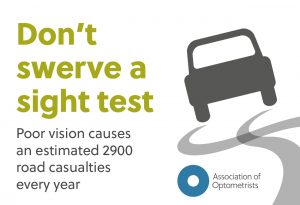As part of Road Safety Week (20-16 November), the AOP (Association of Optometrists) has undertaken further research into vision standards and driving. Sadly since this story hit the news we have heard accounts of people being seriously injured or even killed by a driver with poor vision. Please don’t sit behind a wheel of a car without perfect vision.
The message is don’t swerve a sight test. If you notice any change to the way you see, visit your optometrist as soon as possible.
The study found that:
- 30% of road users have doubted whether their vision is good enough, yet continued to drive
- 26% say they’ve delayed getting their eyes checked by an optometrist despite suspecting their vision was getting worse
- Less than half (40%) would stop driving if they were told their vision, even with glasses or contact lenses, was below the legal standard for driving. With 10% saying that they would continue to drive as normal
- 16% admit to knowing a driver whose sight they believe to be below the legal vision standard.
The AOP has provided the following information to help drivers understand how to check that their vision is roadworthy.
How to check your vision
You can test yourself by reading (with glasses or contact lenses, if necessary) a car number plate made after 1 September 2001 from 20 metres. You should check this yourself regularly. Your optometrist will check your vision on a Snellen chart during a sight test.
Driving with eyesight below the required standard is illegal and may also mean your motor insurance is not valid.
Medical conditions
You must tell the DVLA about certain eye or general medical conditions. For a full list of conditions you must declare, see www.gov.uk/health-conditions-and-driving.
The most common conditions (but not the only ones) affecting vision are age-related macular degeneration, cataracts, glaucoma and diabetic retinopathy.
If you are a group 1 driver, you must tell the DVLA if you have a medical condition affecting both eyes, including different conditions in each eye. You can either report your condition online or ll in form V1 and send it to the DVLA.
The DVLA may send you for a field-of-vision test in which lights are flashed in the edge of your vision to make sure you can see them. People are generally very poor at judging their own field of vision, and blind spots in your vision create a risk of accidents, especially involving pedestrians.
What should I do if I feel my vision is getting worse for driving?
You should see your optometrist who will be able to tell you if you need a new prescription, whether you need to be referred to an ophthalmologist (eye doctor), or if you have a condition that should be declared to the DVLA.
If you think that your eyesight has deteriorated or you haven’t had your eyes examined in the last two years, you can book in for a comprehensive eye examination by calling 0131 225 2235. Don’t swerve an eye test!











